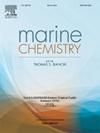Nitrous oxide variability along an estuary influenced by agricultural land use (Guadalquivir estuary, SW Spain)
IF 2.5
3区 地球科学
Q2 CHEMISTRY, MULTIDISCIPLINARY
引用次数: 0
Abstract
The Guadalquivir Estuary is the largest estuary in the southwest basin of the Iberian Peninsula, which is subject to strong anthropogenic influence such as the damming or the multitude of crop fields on its margins. Nitrous Oxide (N2O) variability is analysed considering the influence of temperature, salinity, water-atmosphere fluxes, benthic fluxes, reactivity and lateral inputs. N2O increases along the salinity gradient, with values ranging from 5.9 to 103.3 nmol L−1. Thus, values of N2O concentration are very close to equilibrium with the atmosphere at the mouth, while in the inner zone the fluxes to the atmosphere are higher, showing the greatest variability of N2O in the estuary (74.26 ± 7.41 μmol m−2 d−1). Sediments act as a source of N2O to the water column, with benthic fluxes presenting a wide range from 2 to 20 μmol m−2 d−1. Denitrification processes in the sediments may be important in the inner part of the estuary, where negative benthic fluxes of nitrate have been observed. Production rates of N2O in the water column are estimated from incubation experiments, resulting in higher production with temperature, and lower with salinity. Lateral inputs are calculated by balance of the different processes characterized and seems to be an important factor influencing N2O variability in the inner zone of the estuary.
受农业用地影响的河口(西班牙西南部瓜达尔基维尔河口)的氧化亚氮变化情况
瓜达尔基维尔河口是伊比利亚半岛西南盆地最大的河口,受到人类活动的强烈影响,如在其边缘筑坝或种植大量农作物。考虑到温度、盐度、水-大气通量、底栖生物通量、反应性和横向输入的影响,对一氧化二氮(N2O)的变化进行了分析。一氧化二氮随盐度梯度增加,浓度值从 5.9 到 103.3 nmol L-1 不等。因此,河口的一氧化二氮浓度值非常接近与大气的平衡值,而内区向大气的通量较高,显示出河口一氧化二氮的变化最大(74.26 ± 7.41 μmol m-2 d-1)。沉积物是水体中一氧化二氮的来源,底栖通量的范围很广,从 2 μmol m-2 d-1 到 20 μmol m-2 d-1。沉积物中的反硝化过程在河口内侧可能很重要,在河口内侧已观察到硝酸盐的负底栖通量。水体中一氧化二氮的产生率是通过培养实验估算得出的,温度越高,产生率越高,盐度越低,产生率越低。侧向输入量是通过平衡不同过程的特征计算出来的,似乎是影响河口内区一氧化二氮变化的一个重要因素。
本文章由计算机程序翻译,如有差异,请以英文原文为准。
求助全文
约1分钟内获得全文
求助全文
来源期刊

Marine Chemistry
化学-海洋学
CiteScore
6.00
自引率
3.30%
发文量
70
审稿时长
4.5 months
期刊介绍:
Marine Chemistry is an international medium for the publication of original studies and occasional reviews in the field of chemistry in the marine environment, with emphasis on the dynamic approach. The journal endeavours to cover all aspects, from chemical processes to theoretical and experimental work, and, by providing a central channel of communication, to speed the flow of information in this relatively new and rapidly expanding discipline.
 求助内容:
求助内容: 应助结果提醒方式:
应助结果提醒方式:


